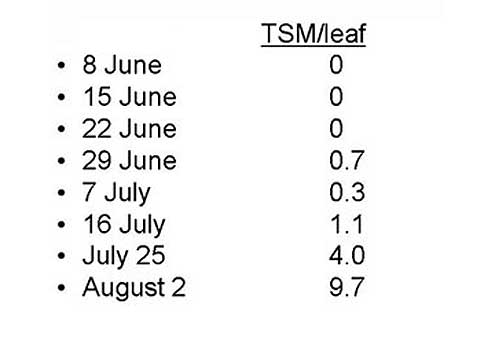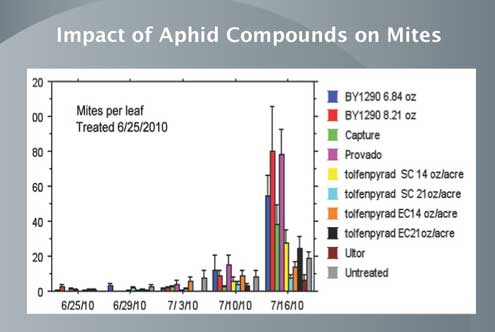Twospotted Spider Mite in Hop
Twospotted spider mite, Tetranychus urticae, causes damage to hops through its feeding action. It is a serious and perennial threat in virtually all Pacific Northwest hop yards. Infestations of T. urticae can lead to yield and quality losses in hops and may contribute to detrimental flavor characteristics.
2013 Miticide Resistance Studies
WSU Masters degree candidate Tara Piraneo details a series of experiments investigating the response of T. urticae to varying levels of abamectin, bifenazate, and bifenthrin in her thesis, Acaricide Resistance of the Two-Spotted Spider Mite in Pacific Northwest Hops.
2011 Compounds Evaluated: Early Season
In our 2010 trials (details below), we noticed treatment effects in mite populations following the early-season treatments we made for hop aphids. In 2011, we deliberatedly evaluated mite impacts from the following aphid treatments.
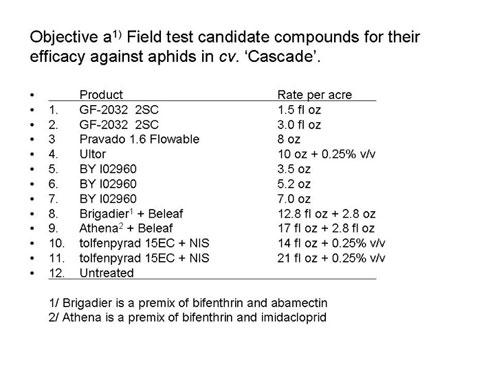
2011 Early Season Results: Mites
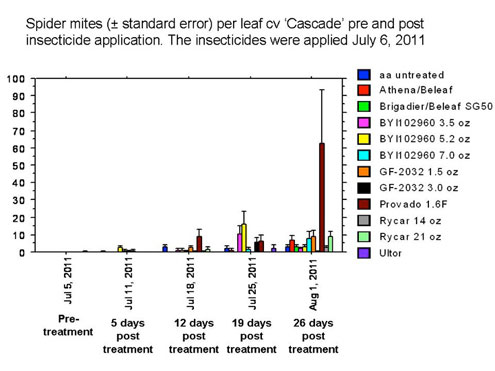
2011 Early Season Results: Mite Eggs
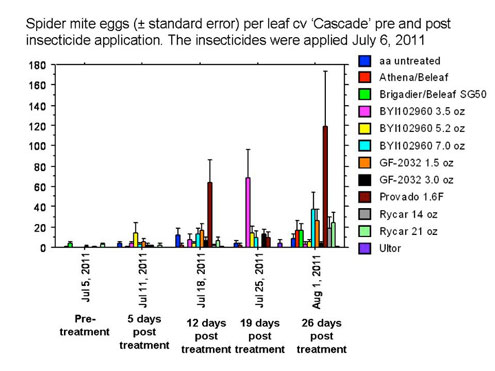
2011 Candidate Compounds: Late Season
The following treatments were slated for 4 August 2011 application.
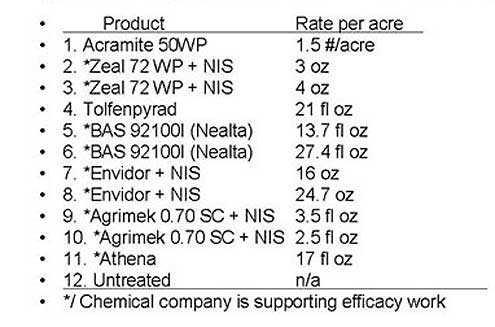
2011 Mite Counts
Due to extremely low mite populations in 2011, as documented below, single-compounds and rotational program efficacy tests were impractical this season.
2010 Compounds Evaluated: Early Season
The following compounds were applied for hop aphid control in 2010, but impacts were also evaluated on mites and are presented in the two charts following.
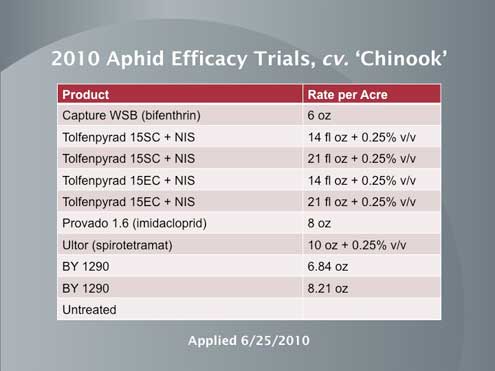
2010 Early Season Results
We were not surprised to see imidacloprid (Provado) flare mites post-application, but flaring also occurred in several other treatments. Spirotetramat (Ultor) did not flare mites, and was very effective on aphid control. It was therefore slated for further study in 2011.
2010 Compounds Evaluated: Late Season
These products were evaluated specifically for their impacts on mites in 2010.
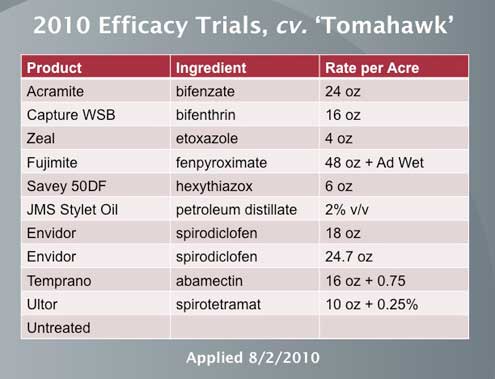
2010 Late Season Results: Mites
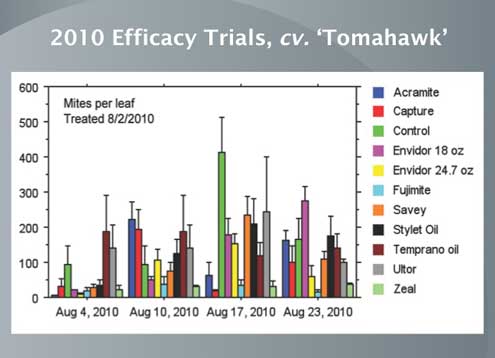
2010 Late Season Results: Mite Eggs

2010 Rotational Program Compounds
To evaluate controls applied in a rotational program, we tracked plots in which the compound in the first column (applied 8-2-10) was followed by application of a different compound, shown in the third column, on 8-31-10.
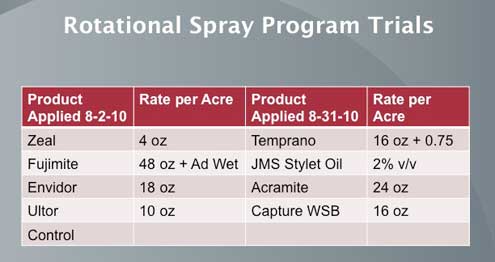
2010 Rotational Program Results
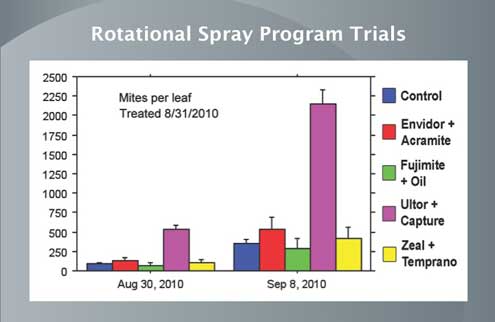
2010 Idaho Efficacy Trials
Six miticides and one aphicide were evaluated for efficacy at the Southwest Idaho Research and Extension Center in Parma, Idaho. Except for BeLeaf, which targets hop aphid, all products target twospotted spider mites. Neither spider mite nor aphid populations developed damaging levels in 2010. Mean spider mite and spider mite egg numbers did not exceed 2 per leaf on treated or control plots. Mean hop aphid numbers did not exceed 4 per leaf on treated or control plots. These numbers were not high enough to detected significant differences in numbers of these pests between treatments.
Treatment |
Rate (Oz. / |
Spider mites |
Spider mite eggs |
Hop aphids |
Acramite 4 SC |
24 |
0.4 ± 0.23 |
1.3 ± 0.51 |
1.8 ± 0.43
|
Agri-Mek 0.15 EC |
16 |
0.5 ± 0.30 |
1.7 ± 0.85 |
2.2 ± 0.49 |
BeLeaf 50 SG |
2.8 |
0.3 ± 0.07 |
0.7 ± 0.26 |
1.4 ± 0.54 |
Envidor 2 SC |
16 |
0.7 ± 0.31 |
1.4 ± 0.74 |
2.2 ± 0.45 |
Onager 1E |
6 |
0.3 ± 0.14 |
1.0 ± .55 |
1.2 ± 0.0.27 |
Ultiflora (Mesa) |
30 |
1.2 ± 0.71 |
1.6 ± 0.95 |
1.7 ± 0.37 |
Zeal |
4 |
0.7 ± 0.34 |
1.3 ± 0.49 |
2.0 ± 0.41 |
UTC |
n/a |
0.92 ± 0.21 |
1.7 ± 0.44 |
3.9 ± 0.97 |
Entomology subpage
This page is designed to provide additional information pursuant to the Entomology component of the overall project discussed on the Washington State University website http://hopmintstress.wsu.edu .
It is not designed to be viewed or utilized independently of that website.
Return to Entomology page.
Return to home page.
TSSM Images
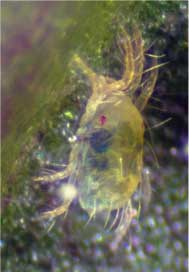
Twospotted spider mite, Tetranychus urticae
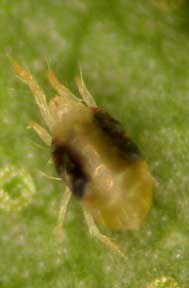
Adult female (note prominent black spots on each side of abdomen); adults are approximately 1/50-inch long
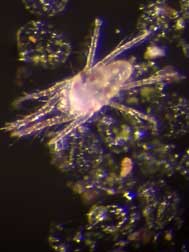
Adult male; males are approximately 3/4 the size of females and have a more pointed abdomen

Adult, nymphs, and eggs; eggs are clear to pearly-white spheres approximately 1/200-inch in diameter
TSSM Damage

Brown bines resulting from TSSM damage

Browned and stunted hop cones caused by TSSM feeding
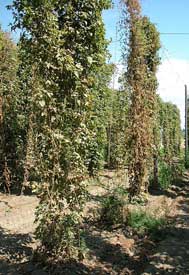
Desiccated bines resulting from TSSM feeding
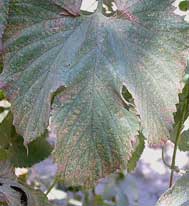
Stippled appearance of hop leaves indicates TSSM damage
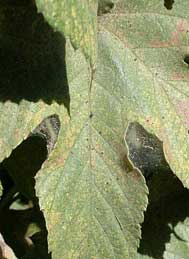
Webbing on hop leaf indicates presense of TSSM
